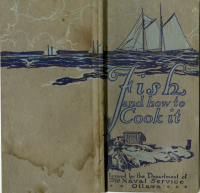Recipes
The Cook's Recipe Manual
This cookbook was published in 1943 as a guide for cooks in the armed forces, munitions plants, camps, and schools. Each recipe makes approximately 100 servings, mainly mainly from ingredients that could be found in military rations.
La Revue Populaire Décembre 1942
La Revue Populaire was a French-Canadian magazine that was first published in 1907, and continued circulation until its final publication in 1963. It was originally created as a magazine for the whole family, but during the Second World War, they started to focus primarily on content for women and girls.
The December 1942 edition shows this transition by featuring an embroidery stencil advertised to young girls and 'holiday meals' for housewives.
Fish and How to Cook It
At the beginning of the First World War, the Department of the Naval Service issued this booklet in response to the low consumption of fish among Canadians at the time. This booklet teaches 'housewives' how to choose the right type of fish for their family's needs, taking into consideration the nutritional value, cost, and flavour of the fish. The booklet also includes pricing charts to be referenced when shopping, as well as dozens of helpful recipes.
100 Tempting Fish Recipes
During the Second World War, fish was one of the few food items that was not rationed. In light of this, the Department of Fisheries attempted to persuade Canadians to buy and consume more Canadian fish. This, they proclaimed, would help the "health and strength" of Canadians, at the same time that it would strengthen the economies of fishing communities. One way the Department of Fisheries aimed to increase fish consumption was by producing recipe books to acquaint housewives with efficient and delicious cooking methods.
Victory Cook Book
This collection of recipes was released by the Navy League Chapter of the I.O.E.D. to raise money towards war work. Find out what women on the homefront cooked for their families.
"Brightening up the drabbest corners of your home"
Wartime restrictions meant making do with what was available - and this booklet provided many ways to breathe new life into old products by using Tintex tints and dyes.
Fighting the war by feeding the family
Everything was militarized during the Second World War, including the household economy. Women became "housoldiers" whose job was to prepare "appetizing and nourishing meals that protect and preserve the health of their families."
Recipe ideas from BC Electric
Wartime rationing made it difficult to prepare tasty and varied meals, but in these pamphlets British Columbia Electric had some suggestions for Christmas dinners, entertaining on special occasions, and quick meals for "the business woman and war workers, for housewives who give much of their time to patriotic work."
Turning ration stamps into healthy meals
Dedicated to "the Canadian Homemaker Whose Time is so Generously Devoted to the War Effort," this book offered hints on keeping the family fit, how to stretch the meat ration, wartime ingredient substitutions, "colourful salads in wartime menus," and desserts under rationing.
"The first line of defense lies in the kitchen"
Originally intended to commemorate the Royal Visit of King George VI and Queen Elizabeth to Canada in 1939, the book was not published until after the Second World War began. Among the contributors were Lady Tweedsmuir and Eleanor Roosevelt.










